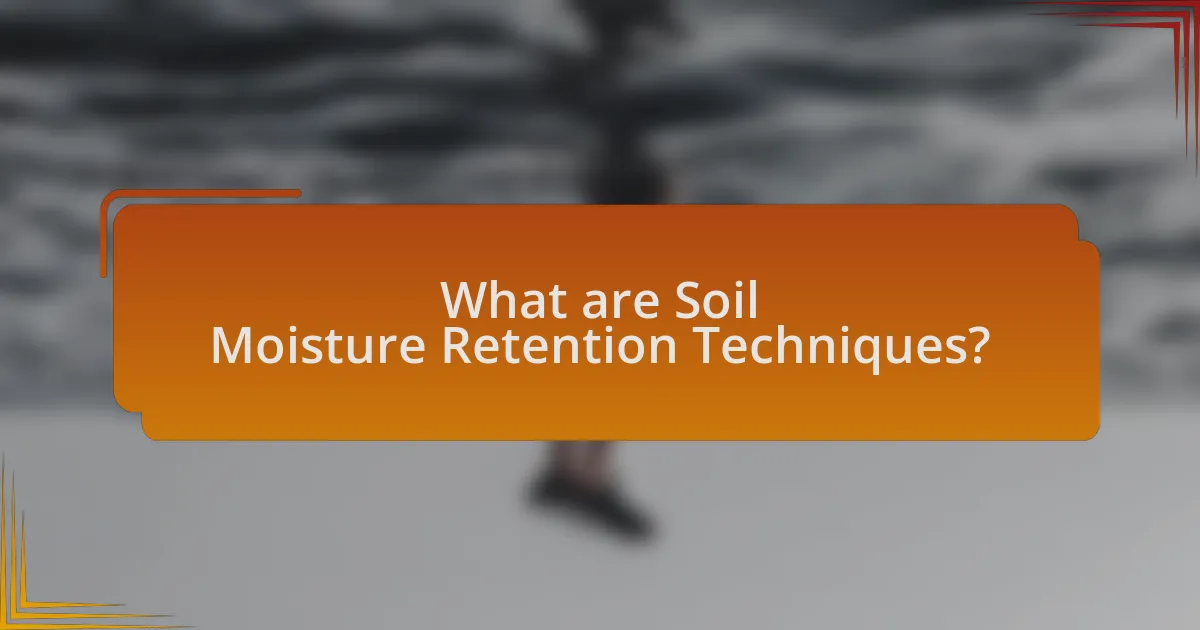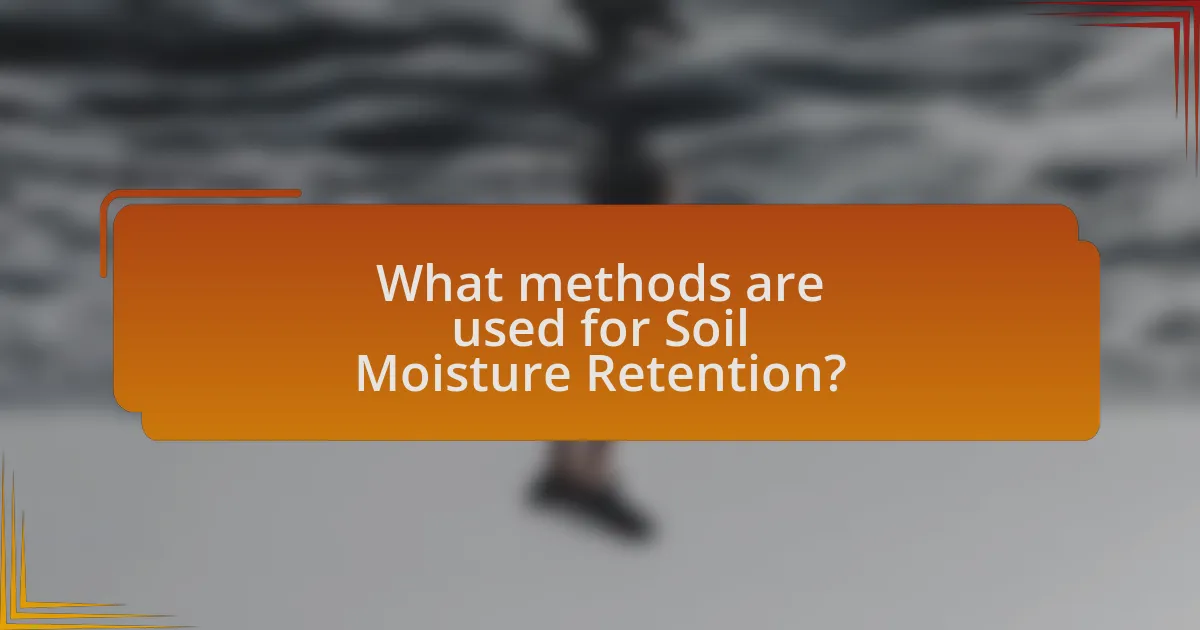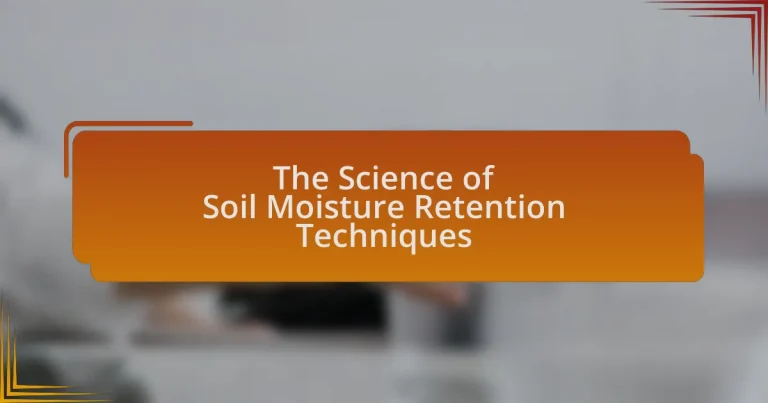Soil moisture retention techniques are essential methods aimed at enhancing the soil’s ability to retain water, thereby improving water availability for agricultural crops. This article explores various techniques such as the use of organic matter, mulching, cover cropping, and contour plowing, highlighting their impact on agricultural productivity and ecosystem health. Key principles include improving soil structure and organic matter content, while the effectiveness of these techniques varies across different climates and soil types. The article also addresses the economic considerations for farmers, the role of technology in optimizing moisture retention, and best practices to avoid common mistakes in moisture management.
What are Soil Moisture Retention Techniques?

Soil moisture retention techniques are methods used to enhance the ability of soil to retain water, thereby improving water availability for plants. These techniques include the use of organic matter, such as compost and mulch, which improve soil structure and increase its water-holding capacity. Additionally, practices like contour plowing and terracing reduce runoff and promote water infiltration. Research indicates that incorporating cover crops can also enhance soil moisture retention by improving soil health and structure.
How do Soil Moisture Retention Techniques impact agriculture?
Soil moisture retention techniques significantly enhance agricultural productivity by improving water availability for crops. These techniques, such as mulching, cover cropping, and the use of organic amendments, help maintain soil moisture levels, reduce evaporation, and increase infiltration. Research indicates that implementing these practices can lead to yield increases of up to 20-30% in drought-prone areas, as they enable crops to access water during critical growth periods. Additionally, soil moisture retention techniques contribute to soil health by promoting microbial activity and nutrient cycling, further supporting sustainable agricultural practices.
What are the key principles behind Soil Moisture Retention Techniques?
The key principles behind Soil Moisture Retention Techniques include improving soil structure, enhancing organic matter content, and utilizing mulching practices. Improving soil structure allows for better water infiltration and retention, as well-structured soil has increased porosity and reduced compaction. Enhancing organic matter content, such as through compost or cover crops, increases the soil’s ability to hold moisture due to the high water retention capacity of organic materials. Mulching practices, which involve covering the soil surface with organic or inorganic materials, reduce evaporation and maintain soil temperature, further aiding moisture retention. These principles are supported by studies indicating that soils with higher organic matter can retain significantly more water, thus improving overall soil moisture levels.
How do these techniques vary across different climates?
Soil moisture retention techniques vary significantly across different climates due to factors such as temperature, precipitation, and soil type. In arid climates, techniques like mulching and the use of organic matter are emphasized to reduce evaporation and enhance moisture retention, as evidenced by studies showing that mulching can reduce soil temperature and evaporation rates by up to 50%. Conversely, in humid climates, techniques may focus on drainage and soil aeration to prevent waterlogging, with research indicating that proper drainage can improve crop yields by 20% in areas prone to excess moisture. Additionally, in temperate climates, a combination of both approaches is often utilized, adapting to seasonal variations in moisture availability.
Why is Soil Moisture Retention important for ecosystems?
Soil moisture retention is crucial for ecosystems because it supports plant growth, maintains soil health, and regulates water cycles. Healthy soil with adequate moisture enhances vegetation productivity, which in turn provides habitat and food for various organisms. Furthermore, effective moisture retention reduces erosion and runoff, promoting groundwater recharge and maintaining hydrological balance. Studies indicate that soils with high moisture retention capacity can improve drought resilience, thereby sustaining ecosystems during dry periods.
What role does soil moisture play in plant health?
Soil moisture is crucial for plant health as it directly influences water availability for physiological processes. Adequate soil moisture supports nutrient uptake, photosynthesis, and overall growth, while insufficient moisture can lead to stress, wilting, and reduced productivity. Research indicates that plants require a specific moisture range to optimize their metabolic functions; for instance, studies show that crops like maize and wheat exhibit significant yield reductions when soil moisture falls below critical levels. Thus, maintaining appropriate soil moisture levels is essential for sustaining healthy plant development and maximizing agricultural output.
How does soil moisture retention affect water conservation?
Soil moisture retention significantly enhances water conservation by reducing the need for irrigation and minimizing water loss through evaporation. When soil retains moisture effectively, it allows plants to access water over extended periods, leading to healthier growth and reduced stress on water resources. Research indicates that soils with high organic matter content can retain up to 20% more moisture than those with low organic matter, demonstrating the critical role of soil health in water conservation efforts.
What methods are used for Soil Moisture Retention?

Methods used for soil moisture retention include mulching, cover cropping, and the use of organic matter. Mulching involves applying a layer of material on the soil surface to reduce evaporation and maintain moisture levels. Cover cropping introduces plants that protect the soil and enhance its moisture-holding capacity. The incorporation of organic matter, such as compost or manure, improves soil structure and increases its ability to retain water. These methods are supported by research indicating that they can significantly enhance soil moisture retention, leading to improved agricultural productivity and sustainability.
How do physical barriers enhance soil moisture retention?
Physical barriers enhance soil moisture retention by reducing evaporation and limiting water runoff. These barriers, such as mulch, stones, or vegetation, create a protective layer that minimizes direct exposure of the soil to sunlight and wind, which are primary factors in moisture loss. Additionally, physical barriers can slow down water movement across the soil surface, allowing more time for water to infiltrate the soil rather than running off into drainage areas. Research indicates that using mulch can reduce soil moisture evaporation by up to 70%, demonstrating the effectiveness of physical barriers in maintaining soil moisture levels.
What types of physical barriers are most effective?
The most effective types of physical barriers for soil moisture retention include mulch, berms, and contour plowing. Mulch, such as wood chips or straw, reduces evaporation and maintains soil temperature, thereby enhancing moisture retention. Berms, which are raised barriers made of soil, help redirect water to plant roots and prevent runoff. Contour plowing involves plowing along the contours of the land, which reduces soil erosion and promotes water infiltration. Studies have shown that these techniques can significantly improve soil moisture levels, with mulch reducing evaporation by up to 70% in some cases.
How can mulching improve moisture retention?
Mulching improves moisture retention by creating a barrier that reduces evaporation from the soil surface. This layer of organic or inorganic material insulates the soil, helping to maintain a consistent moisture level by preventing rapid drying. Studies have shown that mulched areas can retain up to 50% more moisture compared to bare soil, as the mulch absorbs rainfall and slowly releases moisture back into the soil, enhancing water availability for plants.
What are the benefits of using organic amendments?
Using organic amendments improves soil health and enhances moisture retention. Organic amendments, such as compost and manure, increase soil organic matter, which improves soil structure and water-holding capacity. Research indicates that soils enriched with organic amendments can retain up to 20% more moisture compared to untreated soils, leading to better plant growth and reduced irrigation needs. Additionally, organic amendments promote beneficial microbial activity, which further aids in nutrient cycling and moisture retention.
How do compost and manure contribute to moisture retention?
Compost and manure enhance moisture retention in soil by improving its structure and increasing organic matter content. The organic materials in compost and manure create a sponge-like effect, allowing the soil to hold more water and reducing evaporation. Studies have shown that soils enriched with compost can retain up to 30% more moisture compared to untreated soils, which is crucial for plant health and growth. Additionally, the microbial activity stimulated by compost and manure further aids in breaking down soil particles, leading to improved water infiltration and retention capabilities.
What are the long-term effects of organic amendments on soil health?
The long-term effects of organic amendments on soil health include improved soil structure, enhanced nutrient availability, and increased microbial activity. Organic amendments, such as compost and manure, contribute to the formation of stable soil aggregates, which improves aeration and water retention. Research indicates that soils amended with organic materials show higher levels of essential nutrients like nitrogen, phosphorus, and potassium over time, promoting plant growth. Additionally, studies have demonstrated that organic amendments foster a diverse microbial community, which is crucial for nutrient cycling and soil fertility. For instance, a study published in the journal “Soil Biology and Biochemistry” found that organic amendments significantly increased microbial biomass and activity, leading to better soil health indicators.
What are the challenges in implementing Soil Moisture Retention Techniques?

The challenges in implementing Soil Moisture Retention Techniques include high initial costs, lack of technical knowledge, and variability in soil types. High initial costs can deter farmers from adopting these techniques, as investments in materials and infrastructure may be significant. Additionally, a lack of technical knowledge among practitioners can lead to improper implementation, reducing the effectiveness of the techniques. Variability in soil types across different regions complicates the application of standardized methods, as techniques that work well in one soil type may not be effective in another. These factors collectively hinder the widespread adoption of soil moisture retention practices.
What factors limit the effectiveness of these techniques?
The effectiveness of soil moisture retention techniques is limited by several factors, including soil type, climate conditions, and management practices. Soil type affects water retention capacity; for instance, sandy soils drain quickly and retain less moisture compared to clay soils, which hold water more effectively. Climate conditions, such as temperature and precipitation patterns, also play a crucial role; high evaporation rates in arid regions can diminish the benefits of moisture retention techniques. Additionally, improper management practices, such as inadequate application of mulch or ineffective irrigation methods, can further reduce the effectiveness of these techniques.
How do soil types influence moisture retention strategies?
Soil types significantly influence moisture retention strategies by determining the soil’s texture, structure, and organic matter content. Sandy soils, for example, have larger particles and lower water-holding capacity, leading to rapid drainage and necessitating frequent irrigation. In contrast, clay soils have smaller particles and higher water retention, allowing for moisture conservation but potentially leading to poor drainage and aeration issues. Loamy soils, which are a balanced mixture of sand, silt, and clay, provide optimal moisture retention and drainage, making them ideal for various moisture retention strategies. Research indicates that soil organic matter can enhance moisture retention by improving soil structure and increasing water-holding capacity, as noted in studies by the USDA Natural Resources Conservation Service.
What are the economic considerations for farmers?
Economic considerations for farmers include costs of inputs, market prices for crops, and potential returns on investment. Farmers must evaluate expenses such as seeds, fertilizers, labor, and equipment against the expected revenue from selling their produce. For instance, in 2021, the average cost of production for corn in the United States was approximately $4.50 per bushel, while market prices fluctuated around $5.50 per bushel, indicating a potential profit margin. Additionally, farmers must consider the impact of soil moisture retention techniques on yield and sustainability, as effective moisture management can lead to higher crop productivity and reduced irrigation costs, ultimately influencing their economic viability.
How can technology improve Soil Moisture Retention?
Technology can improve soil moisture retention through the use of advanced irrigation systems, soil sensors, and moisture-retaining materials. Smart irrigation systems utilize data from soil moisture sensors to optimize water application, ensuring that plants receive the right amount of water at the right time, which reduces water waste and enhances moisture retention in the soil. Additionally, soil sensors provide real-time data on moisture levels, allowing farmers to make informed decisions about irrigation schedules, thereby preventing overwatering and promoting healthier soil structure. Furthermore, the incorporation of moisture-retaining materials, such as hydrogels or organic amendments, can significantly enhance the soil’s ability to retain moisture, leading to improved crop yields and reduced irrigation needs. Studies have shown that these technologies can lead to water savings of up to 30% in agricultural practices, demonstrating their effectiveness in improving soil moisture retention.
What role do sensors and data analytics play in moisture management?
Sensors and data analytics are crucial in moisture management as they enable precise monitoring and analysis of soil moisture levels. Sensors, such as soil moisture probes, provide real-time data on moisture content, allowing for timely irrigation decisions. Data analytics processes this information to identify patterns and predict moisture needs, optimizing water usage and enhancing crop yield. For instance, studies have shown that using soil moisture sensors can reduce water usage by up to 30% while maintaining crop health, demonstrating the effectiveness of these technologies in sustainable agriculture.
How can irrigation systems be optimized for better moisture retention?
Irrigation systems can be optimized for better moisture retention by implementing techniques such as drip irrigation, soil moisture sensors, and mulching. Drip irrigation delivers water directly to the plant roots, minimizing evaporation and runoff, which can lead to significant water savings—studies show that drip systems can reduce water usage by up to 60% compared to traditional methods. Soil moisture sensors provide real-time data on soil moisture levels, allowing for precise irrigation scheduling that prevents overwatering and promotes deeper root growth. Additionally, applying organic or inorganic mulch helps retain soil moisture by reducing evaporation and regulating soil temperature, with research indicating that mulching can decrease moisture loss by 30% or more. These methods collectively enhance the efficiency of irrigation systems, leading to improved moisture retention in the soil.
What best practices should be followed for effective Soil Moisture Retention?
To achieve effective soil moisture retention, implementing practices such as mulching, maintaining organic matter, and utilizing cover crops is essential. Mulching, which involves applying a layer of organic or inorganic material on the soil surface, reduces evaporation and helps regulate soil temperature. Maintaining organic matter through composting or adding organic materials enhances soil structure, increases water-holding capacity, and promotes beneficial microbial activity. Additionally, using cover crops prevents soil erosion, improves soil health, and retains moisture by providing ground cover during off-seasons. These practices are supported by research indicating that mulched soils can retain up to 50% more moisture compared to bare soils, demonstrating their effectiveness in moisture retention strategies.
How can farmers assess their soil moisture needs?
Farmers can assess their soil moisture needs by utilizing soil moisture sensors, which provide real-time data on moisture levels in the soil. These sensors measure the volumetric water content and help farmers determine when irrigation is necessary, optimizing water usage. Research indicates that using soil moisture sensors can reduce water consumption by up to 30% while maintaining crop yield, demonstrating their effectiveness in managing soil moisture needs.
What are the common mistakes to avoid in moisture retention practices?
Common mistakes to avoid in moisture retention practices include overwatering, which can lead to waterlogged soil and root rot, and neglecting soil aeration, which is essential for healthy root development. Additionally, using inappropriate mulch types can hinder moisture retention instead of enhancing it. Failing to monitor soil moisture levels can result in either under- or over-irrigation, both detrimental to plant health. Lastly, not considering the specific moisture needs of different plants can lead to ineffective moisture management. These mistakes can significantly impact the effectiveness of moisture retention techniques, ultimately affecting plant growth and soil health.


